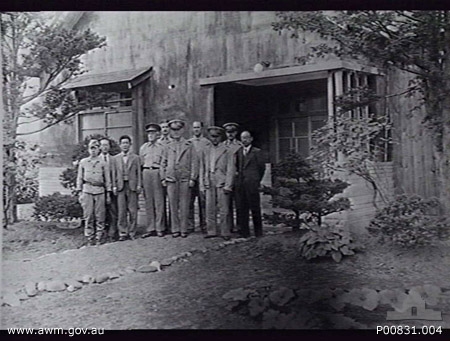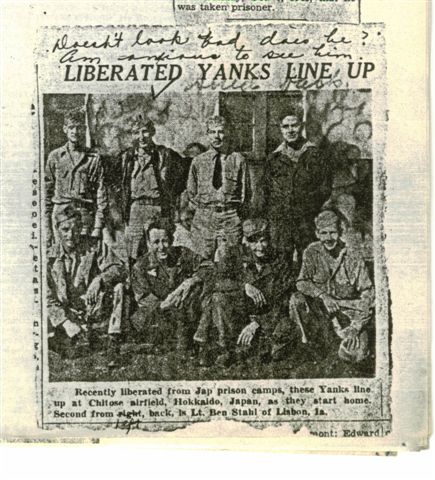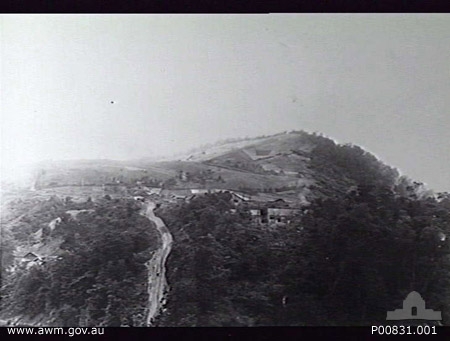|
Hakodate # 4 - Nishi Ashibetsu
The following North China Marine officers were held at Hakodate #4, Nishi-Ashibetsu from July to September of 1945:Col William Ashurst, Maj Luther Brown, Capt James Climie, Capt James Hester, Capt John White, 1st Lt George Newton, 1st Lt Richard Weber, Navy Commander (Dr) L Thyson, and Chief Marine Gunner William Lee.
Major McCaulley had been repatriated in September of 1943, 2nd Lieutenants Huizenga and McBrayer escaped while enroute to China in May of 1945, Dr Foley had been sent with the civilians to Sendai # 11, and Dr Pollard had been sent to nearby Hakodate # 3, Utashinai.
This then accounts for all the officers of the North China Marines.
In July of 1945 some POWs from Kiangwan arrived at Nishi-Ashibetsu. Kiangwan had been closed down and all POWs transferred, first to Fengtai near Peking, then to Japan. It appears most of the military POWs were sent to the northern island of Hokkaido, most of the civilians to Sendai #11 on Honshu. The officers from the North China and Wake Island Marines were separated from their men and sent to Hakodate #4, called Nishi-Ashibetsu. The enlisted men were sent to Hakodate #2 and #3. All three camps were close in proximity.The information below comes from North China Marine Captain John A. White's book The United States Marines in North China. In early July of 1945 the officers arrived at Nishi-Ashibetsu. It was a fenced compound with a 150 by 20 foot dilapidated shack. Already there were some Australian Army POWs. (White makes reference to some British officers also, but they may have come with them from Kiangwan.) The camp commander was a young first lieutenant. The galley had 3 iron pots of 5 gallons each. It was located at the front of the barracks. Next was a wash and laundry room, the Australian bunk area, the POWs from China bunk area, and then the benjo, or bathroom (latrine). The latrine vats were often overflowing and rats were plentiful. A six foot wide earth floor ran down the center of the barracks, dividing the sleeping platforms which were raised about 18 inches.Captains and below were put into work details. The camp provided labor for the Mitsui coal mine. Work included shoveling gravel into gondola freight cars and unloading logs from boxcars. Rest days came on the 10th, 20th, and last day of the month. At times the POWs carried rakes, hoes, and shovels about a half mile from camp to clear a hillside field for the planting of buckwheat.At noon on 15 August 1945 the POWs were allowed to quit working. On the afternoon of the 17th they were told of Japan's surrender. On 20 August the officials of the Mitsui Mining Company invited Colonel Ashurst and several other officers to a dinner. The following is a list of the POWs that attended:
Americans: Maj L A Brown, Maj J P S Devereaux, Capt J A White, Capt H C Freuler, Lt W M Kessler, Lt W W Lewis, Lt M Llewis
Australians: Col J J Scanlon, Maj J R P Clark, Maj J Edmonds-Wilson, Capt S G Nottage, Capt R A McDonald, Capt P H Brown, Lt E R Almond, Lt J RBadham
(All Americans were Marines except for M Lewis who was Army Air Corps)
On 21 August B-29s made the first food drop. Supplies included cans of beef, ham, powdered milk, chocolate bars, cheese, dried and canned fruit, K rations, and cigarettes. Recent magazines were included. In early Spetember Col Ashurst ordered Maj Devereux to go to Camp # 3 to take command until rescue. Apparently Camp # 3 had mostly Wake Island POWs and Devereux had been their commanding officer there. Capt White was ordered to take command of Camp # 2 where there was a number of North China Marines. He left by truck on September 4th for the short ride to Camp # 2. White stated in his book there were about 110 POW, North China Marines, Navy medical personnel, and a few Wake Island Marines at Camp # 2. (Rescue rosters, however, show only 28 North China Marines at Camp # 2 and twice that at Camp # 3. See page for Hakodate # 2 or Hakodate # 3 for further explanation.) American ground forces first reached Camp # 2 on 12 September 1945 by jeep. They made arrangements for the POWs to leave. On 15 September the POWs marched 2 miles to a train station, then travelled by train to Chitose airport near Sapporo. They flew out on 16 September. Captain White mentions he gave a complete camp roster to a major from the Judge Advocate General Corps. The other Hakodate camps had gone out 2 days earlier than his group. Photo below is some of those attending dinner mentioned above at Mitsui Company Club House.

from Australian War Memorial collections
Picture below from John A. White's book The United States Marines in North China, first published in 1974, as is the photo of Col Ashurst and Maj Brown.
in photo above Back row L to R Marine 1st Lt Richard D Weber, unk Australian, Marines Capt Herbert C Frueler, Capt James R Hester, Capt John A White, Capt Frank C Thurin, Navy Ensign Barney M. Williams Front row L to R Army 2nd Lt George T Walsh, Army 2nd Lt Murray L Lewis, Marines 1st Lt George R Newton, 2nd Lt Robert Greeley, 2nd Lt Wallace W Lewis
Photo below is looking south from the camp fence. POWs walked up that road to work in the fields. Photo from Australian War Memorial collection.
Click here to see entire roster for Nishi-Ashibetsu
From all I have heard and read Colonel Ashurst and Major Brown were excellent examples of United States Marine Corp officers. They continually intervened with the Japanese on behalf of their men.
The Transfer from Kiangwan to Nishi-AshibetsuCol William W. Ashurst replied in letters dated 23 Oct 45, 7 Jan 46, and 1 May 46 to questions from a Captain Smith in the War Department. In the 1 May 46 letter he includes the following information on the transfer: (In the Oct 45 letter Ashurst puts the total numbers for Woosung and Kiangwan from approximately 2800 to approximately 985 over the years. There were Americans, British, Norwegians, Estonians, and Italians. Other reports list the total at 1800. In the other letters Ashurst uses the 1800 figure as the total.)He said he kept a complete record of the North China Marines in captivity but the Japanese took it away and destroyed it on 17 Jun 1945.Prior to May 1945 about a thousand military and civilian POWs were transferred to Japan from Woosung and Kiangwan. On 9 May 1945 996 POWs left by rail for Fengtai. They passed through Shanghai, Nanking, Soochowfoo, and Tientsin. They arrived at Fengtai the morning of 15 May 1945. Fengtai was their worst experience as they lived in large warehouses on dirt or brick floors. There was much sickness between time of arrival and departure on 19 June."On June 19, 1945 left Fengtai near Peiping via rail - Tientsin, Chinwangtao - Mukden, Manchuria - to Fusan, Korea by water to Japan arriving June 29, 1945 (Four days in a filthy camp at Fusan and aboard a crowded, dirty, foul-smelling, louse-and-flea-ridden holds of a prison ship, four decks down, interspersed with diseased Korean Coolies, for a heat-exhausting and stormy trip for two days and one night while crossing mine-submarine-infested waters of the Strait of Tsushima from Korea to Japan.) Then by rail Kobe, Nagoya, Osaki, Tokyo to the Island 'Hakodate' arriving there July 4, 1945. We were taken on north then by rail to camps in an area called "Nishi-Ashibetsu, Hokkaido, Japan. The officers were then separated from the men and placed in "Hakodate War Prisoner's Branch Camp No. 4., Nishi-Ashibetsu, Hokkaido, Japan."The letter says they were released from here 14 Sep 45. There were many camps in the area "three of ours, some of men from the Philippines, some Dutch and more British and Australian. Our officers were in Camp No. 4 with 48 Australian officers." The Australians were in Camp 4 about two weeks before Ashurst's group arrived 7 Jul 1945.Ashurst listed the following for departure on 9 May 1945 from Kiangwan.Group AAmericans: USMC - 1 Col, 2 Majors, 7 Captains, 5 1st Lt, 3 2nd LtUSN - 1 Commander, 1 LtCommander, 1 Lt, 2 Lt(jg), 3 EnsignUSA - 1 Major, 1 Captain, 10 1st Lt, 7 2nd LtUSMC 1 CWO, 4 WO309 USMC enlisted, 40 USN enlisted, 8 USA enlisted29 Merchant Marine officersBritish: Army - 1 Capt, 2 LtNavy - 1 Lt Commanderenlisted 29 Army, 7 Navy25 British Merchant Marine officersTotal Group A 500 men Group BUs Merchant Marine crew and civilians 223Norwegian Merchant Marine officers 5Italian officers 9, enlisted 61, Merchant Marine officers 2Total Group B 300 men Group CAmericanOfficer (MC) USN 1 1st Lt(jg)Enlisted (MC) USN 7Merchant Marine crew and civilians (white) 100civilians Oriental 88Total Group C 196 Groups A, B, and C were evidently then sent to different areas of Japan. Group A was most likely the group sent to Hokkaido and Group C was probably the group sent to Sendai # 11. The Gibbs report for Sendai # 11 lists a detail of 198 American prisoners from Fengtai being the first occupants of the camp, arriving on 4 Jul1 945. The list includes 4 Army, 1 Navy, 7 Marines, and 186 civilians. Doctor William Foley was the senior officer. The 7 USMC were actually Navy corpsmen Loy Black, Herman Davis, William Hunt, Earl Johnson, William Riley, John Ryan, and Arthur Schrader (all 7 captured with the North China Marines). At least some of group B ended up in places like Rokuroshi and Naoetsu. A document dated 10 Sep 1945 discussing the 19 Jun 1945 shipment from Fusan to Japan has 300 Americans, Norwegians, and Italians being located in the Tokyo area, 196 Americans in the northern part of Honshu (this would be Sendai # 11), and the remaining Americans and British in Hokkaido.Major Brown's information verifies that of Colonel Ashurst.
 Army Lt Ben Stahl was also at Ashibetsu. Photo courtesy of his daughter Lyn.
Click below to return to:
|
|




